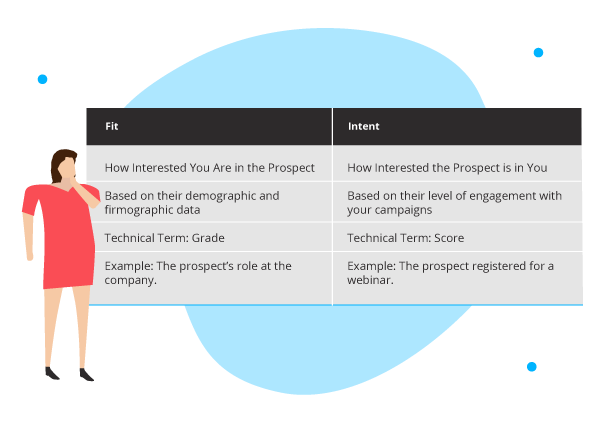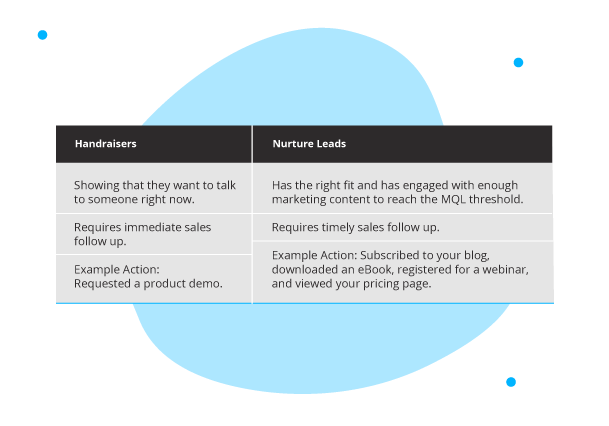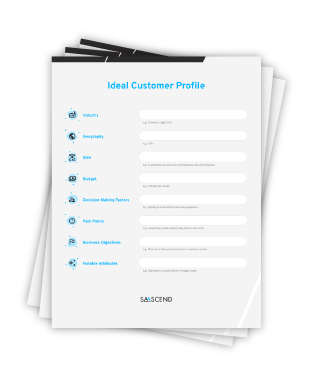
Your lead qualification process is a line of defense, your acting gatekeeper to your sales team. Your sales team’s time is very valuable and when spent on the wrong leads, that means that they are spending less time with the right leads that have a higher likelihood of doing business with you. Which is why your lead qualification process must be optimized in order to protect the time of your sales team, so they can have better meetings with the right prospects and the team can drive more revenue for the business.
How do you achieve better lead qualification? We discuss this more in-depth in our eBook, The Ultimate Guide to Lead Qualification, but to get you started, we wanted to share four gold standards that your team can use to advance your own lead rating process.
4 Best Practices
1 – Use BOTH Fit and Intent to Qualify Your Leads
Fit is how well the lead aligns with your ideal buyer profile. Are they a good fit for your business? Do they have buying authority? Intent is how much interest they have shown in your business. What actions have they taken to exhibit that they might want to do business with your company? How much engagement have they shown with your organization (fig 1)?

Figure 1, In technical terms, these two measurements are referred to as Grading and Scoring. Grade is associated with fit and Score is associated with intent or a prospect’s level of engagement.
There are three benefits to using these two measurements for lead rating.
❶ It helps Sales to reach out at the right time. If Sales engages too soon, then it could result in a waste of time for both parties, or the prospect could get annoyed that sales has reached out when they are not showing any real interest, tarnishing the relationship before it really starts.
❷ It helps to disqualify the students and interns from doing research. A prospect might have a really high engagement score as they attend all your webinars, download all your eBooks, and subscribe to your newsletter, but their level of buying authority either does not exist, or they are too far away from the decision maker to even be considered as an influencer on a deal.
❸ It empowers marketers with insight to quickly evaluate the quality of leads that they generate from their different campaigns. It is not about the quantity, but the quality. If marketing receives 5,000 leads from an event, but the majority of them have a low level of fit with the business, then they know not to invest budget into that event next year.
Therefore, when refining your lead rating process, consider how you can use a separate visual measurement, such as a grade, to rate leads on their level of fit with your business, in combination with their level of intent.
2 – Have Marketing and Sales Collaborate to Define Your MQL Threshold
Your Marketing Qualified Lead (MQL) threshold is the rating at which a lead reaches for them to be considered vetted enough to be sent onto sales for further qualification. The MQL rating uses the combination of fit and intent as described previously. According to HubSpot, “only 5% of salespeople said leads they receive from marketing were very high quality.” This can happen more often than not if the teams have not met to discuss what the definition of an MQL should be.

VP of Marketing Operations, Stephen Stouffer, shared during this Ops Cast podcast interview, that the definition of an MQL is flawed when it is created solely by marketing, because the number of MQL’s generated is often a metric that marketing is held accountable to. When this happens, it further dramatizes the schism between marketing and sales. The two point fingers saying, “Sales is not following up on our leads.” while the other is saying “The leads are weak.”
Sales knows the type of leads that they want to be talking to. They have BANT (Budget, Authority, Need, Timing) criteria that they use in combination with a list of qualifying questions that they ask during their initial discovery calls to determine if the lead is a good fit for their business or not.
Marketing can use these questions throughout their lead capture process in their forms and chatbots, helping to better qualify leads and send over the right type of prospects to sales. The two departments should have this alignment conversation and then define their MQL criteria in their Service Level Agreement.
In addition to aligning on the qualifying criteria for the prospect’s demographic and firmographic attributes, the two should also agree on the types of actions that a prospect could take that would exhibit a higher level of intent, so that a score threshold can be established.
If marketing and sales are not already aligned under the same bottom line metric, revenue, then getting the two to team up may be challenging, but getting them to have the lead qualification discussion is a good start.
3 – Establish the Difference Between Handraisers vs. Nurture Leads
The previous best practice mentions how sales and marketing need to discuss the actions that a prospect needs to take or the intent that they need to show to qualify as someone that is ready to talk to sales as long as the fit is there.
Certain actions qualify a lead as a Handraiser, while the rest of the marketing leads that are sent over to sales that have reached your MQL threshold are considered Nurture Leads (fig 2). Handraisers are the leads that are actively raising their hand saying, “I want to get in contact with someone.” Actions that typically categorize a person as a handraiser include:
❶ Submitting to your contact us form
❷ Requesting a demo
❸ Requesting an audit
❹ Saying that they would like to learn more about your services in chat
❺ Signing up for a free trial

Figure 2, Define the difference between your handraisers and nurture leads to align sales and marketing on what the follow up should entail.
When a Handraiser lead takes action, what happens next is critical, because when the lead is responded to within 5 minutes or less, they are 100x more likely to convert to an Opportunity (Chili Piper). If sales and marketing do not take the time to align on the hand-off process that occurs when a Handraiser lead comes through, then the consequence could be missing out on a deal.
Establish the difference in prospect actions and fit that qualify a lead as a Handraiser instead of a Nurture Lead, so that your team can be ready to respond and provide the best experience possible the next time someone raises their hand to connect with your team.

250 RECORDS FREE
Be Confident That Your Lead Data is Accurate with Job Change Tracking
4 -Take Into Consideration Your Target Account Exceptions
For teams doing an account based approach, you already have a list of targets that you have noted as an ideal fit for your business. If you are using data enrichment tools, you may already have a list of potential contacts on the buying committee that you want to engage with at each account.
As we know the accounts that these leads are associated with are already pre-qualified, the questions to ask yourself to consider your target accounts for your lead qualification process are:
- How much action do they need to take before being sent over to sales?
- What if the lead is at the associate level versus someone at the decision maker level?
- What if someone from the C-Suite has engaged with a marketing campaign for the first time?
- How do we walk the fine line of reaching out too soon versus reaching out at the right time?
As mentioned earlier, reaching out too soon could result in a bad experience on both sides, but per our last point about the importance of a timely response, not reaching out soon enough could result in a loss of a chance to win their business. This is why it is critical to have this discussion to make sure that both marketing and sales are aligned on how leads should be handled that inbound from target accounts.
The Result of a Better Lead Qualification Process
A better lead qualification process results in sales having more at bats with the right people that could potentially buy from your business, resulting in more revenue and an accelerated funnel. The Founder & CEO of BurnRate, Robert McLaws shared how his team was able to to double their output and go from about a 9:1 close rate to a 4:1 close rate all from being able to disqualify the leads that were not a good fit for their sales team to be spending their time, energy, and effort on in the first place.
How much more business could your team win if their lead qualification process was advanced even by a small incremental amount? How much better could your win rates be and your revenue grow if you automatically had a gatekeeper disqualifying leads that are not a good fit for your business?
Consider the optimizations that you could make, put them into practice, and then measure the before and after to analyze the improvements at work.
Refine Your ICP to Advance Lead Quality & Increase Win Rates




